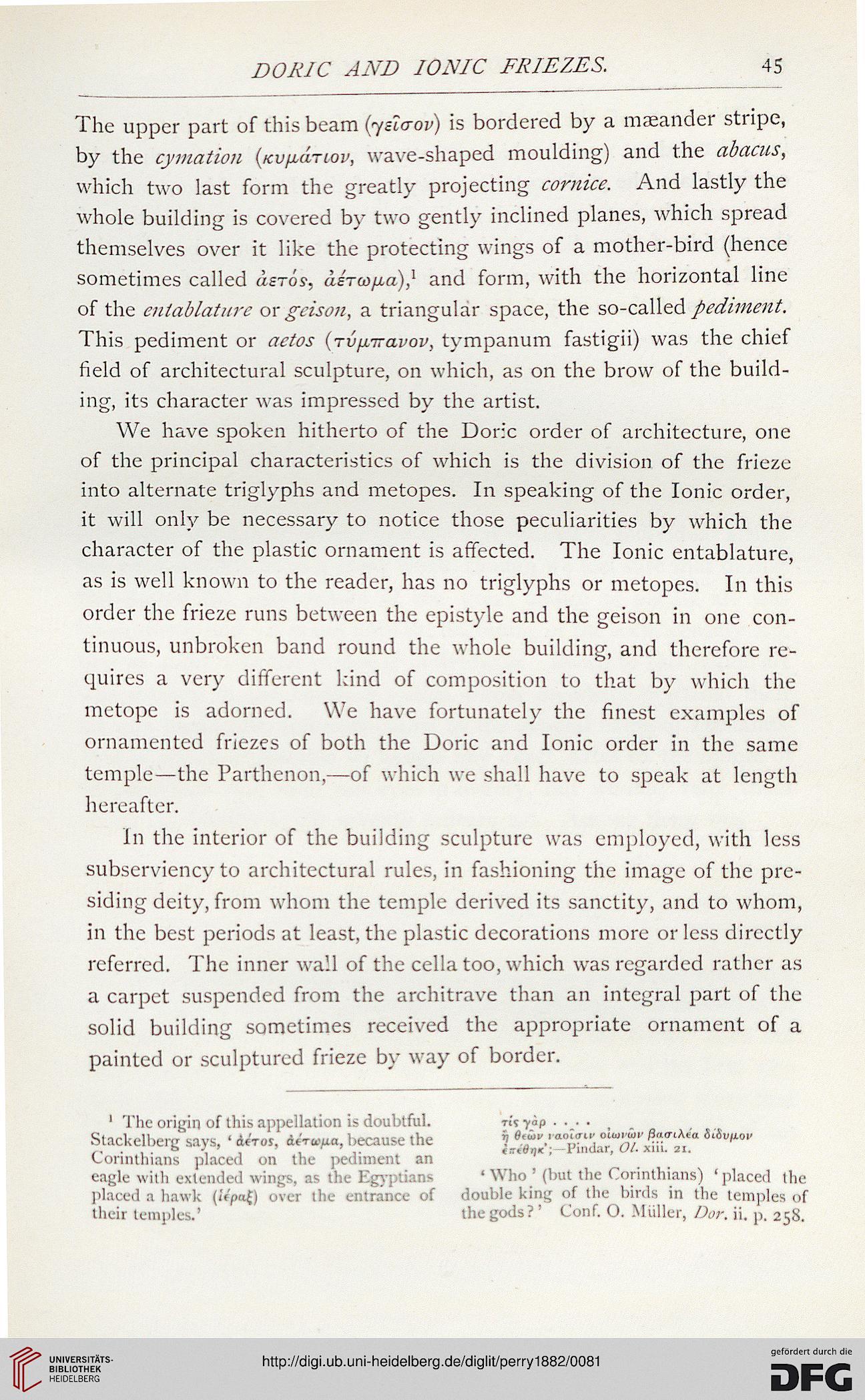45
The upper part of this beam (yelcrov) is bordered by a maeander stripe,
by the cymation (kv/iotiov, wave-shaped moulding) and the abacus,
which two last form the greatly projecting cornice. And lastly the
whole building is covered by two gently inclined planes, which spread
themselves over it like the protecting wings of a mother-bird (hence
sometimes called dsros, aeVw/ia),1 and form, with the horizontal line
of the entablature or gcison, a triangular space, the so-called pediment.
This pediment or actos (TVfnravov, tympanum fastigii) was the chief
field of architectural sculpture, on which, as on the brow of the build-
ing, its character was impressed by the artist.
We have spoken hitherto of the Doric order of architecture, one
of the principal characteristics of which is the division of the frieze
into alternate triglyphs and metopes. In speaking of the Ionic order,
it will only be necessary to notice those peculiarities by which the
character of the plastic ornament is affected. The Ionic entablature,
as is well known to the reader, has no triglyphs or metopes. In this
order the frieze runs between the epistyle and the geison in one con-
tinuous, unbroken band round the whole building, and therefore re-
quires a very different kind of composition to that by which the
metope is adorned. We have fortunately the finest examples of
ornamented friezes of both the Doric and Ionic order in the same
temple—the Parthenon,—of which we shall have to speak at length
hereafter.
In the interior of the building sculpture was employed, with less
subserviency to architectural rules, in fashioning the image of the pre-
siding deity, from whom the temple derived its sanctity, and to whom,
in the best periods at least, the plastic decorations more or less directly
referred. The inner wall of the cella too, which was regarded rather as
a carpet suspended from the architrave than an integral part of the
solid building sometimes received the appropriate ornament of a
painted or sculptured frieze by way of border.
1 The origin of this appellation is doubtful.
Stackelberg says, ' d«Vos, itrufia, because the
Corinthians placed on the pediment an
eagle with extended wings, as the Egyptians
placed a hawk (<«'pa{) over the entrance of
their temples.'
rtf yap . .
ij Btdv raoitrir olwi'wr flatTiAia didiffiol'
crrttfij*'; Pindar, 01. xiii. 21.
' Who ' (but the Corinthians) ' placed the
double king of the birds in the temples of
the gods ? ' Conf. O. Miiller, Dor. ii. p. 258.
The upper part of this beam (yelcrov) is bordered by a maeander stripe,
by the cymation (kv/iotiov, wave-shaped moulding) and the abacus,
which two last form the greatly projecting cornice. And lastly the
whole building is covered by two gently inclined planes, which spread
themselves over it like the protecting wings of a mother-bird (hence
sometimes called dsros, aeVw/ia),1 and form, with the horizontal line
of the entablature or gcison, a triangular space, the so-called pediment.
This pediment or actos (TVfnravov, tympanum fastigii) was the chief
field of architectural sculpture, on which, as on the brow of the build-
ing, its character was impressed by the artist.
We have spoken hitherto of the Doric order of architecture, one
of the principal characteristics of which is the division of the frieze
into alternate triglyphs and metopes. In speaking of the Ionic order,
it will only be necessary to notice those peculiarities by which the
character of the plastic ornament is affected. The Ionic entablature,
as is well known to the reader, has no triglyphs or metopes. In this
order the frieze runs between the epistyle and the geison in one con-
tinuous, unbroken band round the whole building, and therefore re-
quires a very different kind of composition to that by which the
metope is adorned. We have fortunately the finest examples of
ornamented friezes of both the Doric and Ionic order in the same
temple—the Parthenon,—of which we shall have to speak at length
hereafter.
In the interior of the building sculpture was employed, with less
subserviency to architectural rules, in fashioning the image of the pre-
siding deity, from whom the temple derived its sanctity, and to whom,
in the best periods at least, the plastic decorations more or less directly
referred. The inner wall of the cella too, which was regarded rather as
a carpet suspended from the architrave than an integral part of the
solid building sometimes received the appropriate ornament of a
painted or sculptured frieze by way of border.
1 The origin of this appellation is doubtful.
Stackelberg says, ' d«Vos, itrufia, because the
Corinthians placed on the pediment an
eagle with extended wings, as the Egyptians
placed a hawk (<«'pa{) over the entrance of
their temples.'
rtf yap . .
ij Btdv raoitrir olwi'wr flatTiAia didiffiol'
crrttfij*'; Pindar, 01. xiii. 21.
' Who ' (but the Corinthians) ' placed the
double king of the birds in the temples of
the gods ? ' Conf. O. Miiller, Dor. ii. p. 258.




